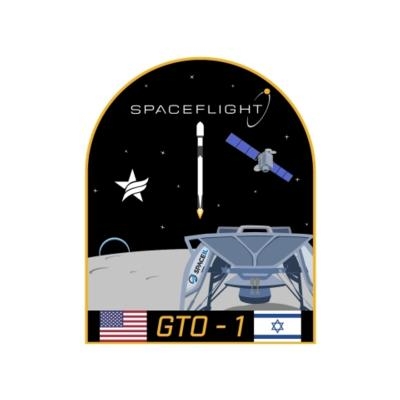Wed, Feb 13, 2019
In Partnership With SSL, Spaceflight Will Send Its First Rideshare Mission To Geosynchronous Transfer Orbit
Satellite rideshare and mission management provider Spaceflight will launch two payloads on its first rideshare mission to Geosynchronous Transfer Orbit (GTO). The mission is scheduled for no earlier than mid-February 2019 aboard a SpaceX Falcon 9 launching from Launch Complex 40 at Cape Canaveral Air Force Station, Florida.

The primary payload on the mission is a telecommunications satellite for the South East Asia region. It was built by SSL, a Maxar Technologies company, which also procured the launch vehicle. Spaceflight will manage the launch of the two secondary payloads, Israeli non-profit SpaceIL’s lunar lander, and the U.S. Air Force Research Lab’s (AFRL) experimental small satellite, S5.
This will be Spaceflight’s first mission beyond Lower Earth Orbit (LEO) and its first combined launch with SSL. In addition to securing capacity aboard the launch vehicle, Spaceflight is handling all the mission management and integration services for the lunar lander, called Beresheet (Hebrew for in the beginning), and AFRL’s spacecraft. This includes a multitude of services, from the unique aspects of pre-launch design, assembly, and integration to the final analysis and testing of the architecture before the spacecraft are encapsulated into the rocket.
While rideshare missions are becoming more and more routine, Spaceflight’s first GTO mission stands apart for several other reasons:
- The spacecraft are headed to two different orbits. Once the Falcon 9 reaches GTO, it will separate SpaceIL’s lunar lander with a custom separation system. Beresheet will orbit Earth, gradually increasing its apogee until it can maneuver to be captured by the Moon's gravity. It will travel to the Moon’s surface under its own power, a voyage taking nearly two months.
- Following Beresheet’s deployment, the AFRL spacecraft, built by Blue Canyon Technologies, will remain attached to the telecommunications satellite as they continue their journey to Geostationary Orbit (GEO). Before the telecommunications satellite reaches its final GEO position, it will separate the S5 spacecraft which will then turn on and start its mission.
- SpaceIL’s four-legged lunar spacecraft, which was competing in the Google Lunar XPrize, will be the smallest spacecraft to land on the Moon, at only 1,322 pounds. Once it has completed its mission, Beresheet will represent Israel’s first spacecraft and the world’s first privately funded spacecraft to reach the Moon. Its mission is to transmit photos and video of its new home and conduct scientific measurements. Upon the mission’s completion, it will remain as a lunar time capsule commemorating this historic accomplishment.

“This is an important mission for Spaceflight as we expand and evolve our customer offerings,” said Curt Blake, CEO of Spaceflight. “The launches we pursue continue to get more sophisticated and demonstrate that our expertise goes beyond identifying and scheduling launches. We also offer valuable integration and deployment services that enable our customers to reach space in a cost-effective manner and get to their desired orbit successfully. With this mission, Spaceflight is demonstrating that the Moon is in reach.”
This mission marks Spaceflight’s inaugural launch of 2019 and the first mission following SSO-A, its historic dedicated Falcon 9 rideshare mission, which launched 64 unique smallsats from 34 organizations from 17 countries in December 2018.
(Images provided with Spaceflight news release)
More News
Performance-Based Navigation (PBN) [ICAO] Area navigation based on performance requirements for aircraft operating along an ATS route, on an instrument approach procedure or in a d>[...]
The Airplane Came To Rest Underneath A Set Of Damaged Power Distribution Lines On The Floor Of A Coulee On June 19, 2025, at 1412 mountain daylight time, a Cessna 172K airplane, N7>[...]
Aero Linx: FAA Managers Association (FAAMA) Recognized by the FAA, FAAMA is a professional association dedicated to the promotion of excellence in public service. The Association i>[...]
From 2023 (YouTube Edition): Jet Central Micro-Turbine Engines Impress Founded in the late-1990s, Mexico City-based Jet Central produces a unique and fascinating line of micro-turb>[...]
Also: ANOTHER Illegal Drone, KidVenture Educational Activities, Record Launches, TSA v Shoes The Senate confirmed Bryan Bedford to become the next Administrator of the FAA, in a ne>[...]
 ANN's Daily Aero-Term (07.10.25): Performance-Based Navigation (PBN) [ICAO]
ANN's Daily Aero-Term (07.10.25): Performance-Based Navigation (PBN) [ICAO] NTSB Prelim: Cessna 172
NTSB Prelim: Cessna 172 ANN's Daily Aero-Linx (07.10.25)
ANN's Daily Aero-Linx (07.10.25) Classic Aero-TV: The Big Business of Diminutive Powerplants
Classic Aero-TV: The Big Business of Diminutive Powerplants Airborne 07.11.25: New FAA Bos, New NASA Boss (Kinda), WB57s Over TX
Airborne 07.11.25: New FAA Bos, New NASA Boss (Kinda), WB57s Over TX




